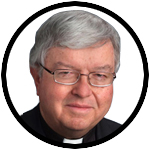
Father Kenneth Doyle
Q. I am a Catholic, but I have forgotten why incense is sometimes used at Mass. Please explain, especially with regard to its use at funerals. (Aumsville, Oregon)
A. The smoke of burning incense is seen by the church as an image of the prayers of the faithful rising to heaven. That symbolism is seen in Psalm 141:2: “Let my prayer be incense before you; my uplifted hands an evening offering.”
Incense is also mentioned in the New Testament Book of Revelation (8:4) as an image of the worship offered to the Almighty in heaven: “The smoke of the incense along with the prayers of the holy ones went up before God from the hand of the angel.”
[hotblock]
The use of incense was common in Jewish worship and carried over into Christian practice. In Exodus, Chapter 30, the Lord instructs Moses to build an altar of incense. Christian ritual books as early as the seventh century mark the use of incense in church services on Good Friday.
The current General Instruction of the Roman Missal (the church’s “guidebook” for liturgical celebrations) permits the use of incense at several different times during the Mass, including at the Gospel and at the elevation of the consecrated bread and wine.
At a funeral Mass, as well as symbolizing the prayers of the congregation directed toward heaven, incensing the casket honors the body of the deceased, which through baptism became a dwelling place of the Holy Spirit.
(One pastoral caution: Occasionally people can be allergic to incense; at a couple of funerals, I have been tipped off in advance about such a concern and have foregone the use of incense at that particular Mass.)
Q. Can you please explain what a pastor’s duties are and whether he has anyone overseeing him? Does he report directly to the bishop? Does the bishop ever meet or check with the pastor to see how things are going? (Syracuse, New York)
A. A pastor, as the word itself signifies, is essentially a “shepherd” entrusted with the care of souls for those in his parish. The pastor’s responsibilities are laid out in Canon 528 of the church’s Code of Canon Law.
They are multiple and include such things as: nourishing the faithful through the sacraments; preaching the word of God and the truths of the faith; providing for Catholic education, especially for children and young people; fostering charitable works and social justice; evangelizing the unchurched and those who have left the faith; and encouraging family prayer.
[hotblock2]
The very next canon (529) instructs the pastor to strive to know his parishioners personally — especially by visiting the sick and those experiencing special difficulties. Depending on the size of the parish and its staff, a pastor might also find himself involved in temporal matters, such as overseeing building projects or managing finances, but his primary duties are spiritual ones, as the code indicates.
As for overseeing the pastor’s performance and his welfare, that can vary somewhat according to the size of the diocese. Dioceses in the U.S. range from a few thousand Catholics to more than a million.
Generally in smaller dioceses, there is frequent interaction between the bishop and his priests, while in larger ones, regular supervision may be entrusted to a vicar for clergy or director of priests’ personnel. Even in “megadioceses,” though, bishops tend to schedule periodic meetings with their priests to share thoughts on pastoral matters and to hear each others’ concerns.
With the decline in the number of Catholic priests in the U.S. (some 58,000 in 1965, 37,000 in 2016), most parishes now have only one priest and that priest is busier than he has ever been. So to counter isolation and loneliness, fraternities of priests (“support groups”) are growing in number — six or eight priests meeting together monthly to share a meal as well as ideas and challenges in ministry.
***
Questions may be sent to Father Kenneth Doyle at askfatherdoyle@gmail.com and 30 Columbia Circle Dr., Albany, New York 12203.
PREVIOUS: Readings of the holy Mass – Twenty-third Sunday in Ordinary Time
NEXT: Mom sings ‘Be thou my vision’ to her son, but what does she see?



Share this story